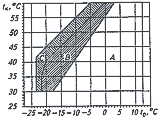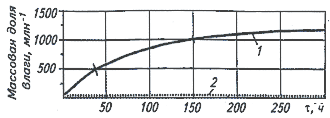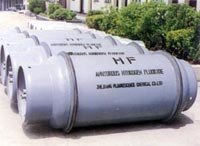

| NEWS | |||||||
| ABOUT | |||||||
| PRODUCTS AND SERVICES | |||||||
|
| |||||||
| PLACE AN ORDER | |||||||
| DOWNLOAD | |||||||
| HELPFUL HINTS | |||||||
| FAQ | |||||||
| LINKS | |||||||
| SEARCH | |||||||
| SITE MAP | |||||||
| CONTACT | |||||||
| русский |
Alternative multi-component refrigerants of HFC groupsR404A refrigerant. It is a near-zeotrope blend R125/R143a/R134a with mass proportion of the components 44/52/4. Temperature glide is less than 0,5 К. Basic physical qualities of R404A are given in the table, and characteristics on the saturation line - in Appendix 13. Depending on the operation conditions, 4...5% increase of cold-productivity and up to 8% discharge temperature reduction compared to analogous characteristics of R502 are ensured.
After having been introduced for sale since the end of 1993 г., R404A has been first used in the new equipment designed for low and average boiling points. At present, R404A is used as an alternative to R502 at retrofit of the systems. At that it is necessary to substitute mineral oil for polyester one and a filter-dehydrator. Changing of composition of the blend (R404A) circulating in the refrigeration system can cause impairment of its energy performance, especially in the patterns with a receiver or in case of considerable length of communication lines. R404A component is R143a, which being pure becomes combustible at pressure 1*105 Pа and temperature 177 oС, and mixed with the air - at volume fraction 60 %. At low temperatures in order to reach combustibility high pressures are required. Therefore, you shouldn't mix R404A with the air or use and allow high air concentrations with a pressure being higher than atmospheric or at high temperatures. R407C refrigerant. Trade mark SUVA® 9000. As an alternative to R22 refrigerant, company "Du Pont" has developed, for using in the air-conditioning systems, R407C refrigerant, whose values of boiling and condensation pressures are close to the corresponding values of R22. Basic characteristics of R407C are given in Appendix 18, and characteristics on the saturation line - in Appendix 15. R407C refrigerant is a zeotrope blend of R32/R125/R134a (mass proportions of the components, correspondingly, 23/25/52%). First, the refrigerant of the following composition has been created: 30/10/60 %. Later, with the aim of fire risk reduction mass proportions of the components have been changed: 23/25/52% (R407C); 20/40/40% (R407A); 10/70/20% (R407B); 10/45/45 % (FX40). Main advantage is that when changing from R22 to R407C, there are not required considerable alterations in the refrigeration system. At present R407C is considered as an optimal alternative of R22 according to cold-productivity and pressure of saturated vapors. On the market of refrigerants R407C is widely introduced and it is bought in those cases when it is necessary to substitute R22 in the operating equipment (with insignificant alterations) or to select a refrigerant instead of R22 for the new equipment. At the same time the majority of companies are concerned with big temperature glide Dtgl = 5...7 К, peculiar for R407C, therefore, mass proportions of the components of suggested blends are varied within a wide range. This drawback considerably impedes servicing of refrigeration systems. Thus, in the systems with several evaporators breakdown of the initial concentration of the actuating fluid charged into the system is possible. Analogous difficulties occur also in the refrigeration systems with the flooded evaporator. While using R407C it is not required to insert any alterations into the refrigeration facility design - it is only needed to substitute refrigeration oil for polyester one, as well as elastomers, absorbents of filters-dehydrators and safety valves. Polyester oils compatible with R407C are extremely hygroscopic. It makes strict demands to the assembly technology of a refrigeration machine. Moreover, R407C is peculiar for very low ( 25...30 % lower than for R22) values of of the coefficient of heat transfer; that's why, heat-exchange apparatus operating on R407C, appear to be more metal-intensive. Leakages out of the refrigeration system will cause changing of the refrigerant composition and its resolvability in the refrigeration oil, and it will effect energy effectiveness and heat- transfer conditions in the evaporator and condenser. Changing of the refrigerant composition in the process of operation will make regulation more difficult and will complicate the procedure of topping-up. Absence of control of the oil concentration in the evaporator can affect the effectiveness of heat-transfer processes occurring there. Thus, presence of 0.2% of polyester oil in the actuating fluid is reducing the coefficient of heat transfer of R407C by 2 %. With 2 % of oil in the refrigerant, coefficient of heat transfer is reducing by 14 %. Characteristics of R407C compared to R22 are given in the table.
Notes: 1.Boiling point is 7,2 oС, condensation point is 43,3 oС, overheating temperature on intake in the compressor is 15,5 oС, overcooling temperature in front of the expansion valve is 40,6 oС. 2. Q0 R407C, Q0 R22 - cold-productivity during operation on correspondingly R407C and R22. As it can be seen from the table, compared to R22, R407C refrigerant has less harmful influence on the environment (value of global warming potential GWP of R407 is almost the same as that of R22, ozone depletion potential ODP is zero). At lower discharge temperature and a bit higher discharge pressure, energy effectiveness of R407C is close to energy effectiveness of R22. In the table there are given actual comparative characteristics of different equipment manufactured for work on R22, at operation on R407C both in the mode of the refrigeration machine and in the mode of the heat pump (equipment wasn't altered during the change for R407C).
* Test conditions (А and B) at operation in the refrigeration mode have been established by the Ministry of Energetics of the USA. The table shows that cold-productivity of this zeotrope blend is approximately 2...5 % lower than that of R22.
It is important that R407C is not intended for operation in the blend with other refrigerants. Addition of R407C to any other refrigerant can cause considerable changes in the indicators of operation effectiveness of the refrigeration system. Ranges of R407C refrigerant use are given on the figure. Before accomplishing operations on changing of the blend traditional refrigerant + mineral oil for the blend R407C + polyester oil, attention is paid on chemical compatibility of the latter with plastics and elastomers. As the research has shown, there is no group of elastomers or plastics, which would suit all alternative refrigerants. It is recommended to check with the producer of the equipment before changing of the refrigerant and inserting structural alterations into the refrigeration system with regard to such elements as pads, seals and piston rings. Refrigeration oil is selected taking into account three factors: oil return into the compressor; lubricating ability and compatibility with materials of the refrigeration facility elements. Polyester oils are recommended to use in combination with R407C. There are a lot of producers of polyester oils; therefore, before selecting oil it is necessary to check with a representative of the company - manufacturer of the compressor, as well as other equipment included into the refrigeration system. Thus, "Copeland" company recommends "Mobil EAL Arctic 22 СС" and "ICI Emkarate RL 32 CF" oils.
Disadvantage of polyester refrigeration oils is big hygroscopicity compared to mineral oils (Fig. up). To absorb moisture with the oil, momentary contact with the environment is enough which makes the oil ineligible for using in the refrigeration system. Since polyester oil is more predisposed confine moisture than mineral oil, it is more difficult to be eliminated using vacuum. Therefore, it is recommended to charge the system with polyester oil whose mass proportion is no more than 50 mln-1. With the help of a filter-dehydrator of the corresponding size, it is possible to keep mass proportion of moisture in the system on the level of less than 50 mln-1. If moisture content in the oil charged into the refrigeration system reaches intolerably high point, it can cause corrosion and copper deposition on adjoint components. Proper vacuumization reduces residual moisture trails till 10 mln-1. The system is vacuumized till pressure 0,3*102Pа or lower. If it is unknown how much moisture is in the system, it is necessary to take the oil probe and check moisture presence. Usually the sight glass (moisture indicator), which is a part of the operating facility, can be used with new refrigerants and oils. However, moisture indicator can show wrong results. Actual level of moisture in the oil will be higher than it is seen in the sight glass.
As it has been stated before, dropping of effectiveness of the refrigeration system operation can occur because of the refrigerant leakage. If in the operating refrigeration system there occurs leakage of both liquid and vapor of R407C out of the section where there is liquid-vapor mixture, composition of the residual part of the refrigerant remains almost the same as it has been initially. After topping-up till the initial quantity of the refrigerant in the system, its productivity is being restored. However, if there occurs leakage of vapor out of the liquid-vapor zone of the non-operating system, composition of the residual part of the refrigerant is changed. In the residual portion concentration of the high-boiling component (R134a) is increased; concentration of the low-boiling components (R32 and R125) is decreased. The consequence of changing of concentrations of the components constituting the refrigerant is changing of composition of R407C blend and parameters of the refrigeration system operation depending on it (table down). Data given in this table are related to operation of the refrigeration compression machine where R407C served as a refrigerant according to the theoretical cycle; moreover, after 50%-leakage (according to mass) out of the vapor phase there have been carried out repeated topping-ups. On the basis of the research of R407C leakage and topping-up processes carried out by "Du Pont" company, there have been made three very important conclusions:
Data given in the table are related to the theoretical research of the refrigeration system operation in the worst conditions. But in practice changes occurring in the refrigerant, as a rule, are less significant. There are experimental data showing that for the heat pump after the second topping-up productivity has stabilized on the value 4% lower than that of the first topping-up.
* Relative refrigerating factor at the initial charging of R407C is accepted as 100%. R507 refrigerant. Trade mark "GenetronAZ50" ("Allied Signal"). Blend composition: R125 and R143a are correspondingly 50 and 50 % according to their mass. Boiling point is -46,7 oС (Appendix 16). Molecular mass is 98,86 gm/mole. Ozone depletion potential ODP = О, global warming potential GWP = 3900. The refrigerant has been developed for retrofit of the low-temperature refrigeration systems operating on R502 and for charging of the new equipment in combination with the use of polyester oils. Characteristics of R507 refrigerant are given below:
According to its characteristics, azeotrope refrigerant R507 is close to R502. While using of R507, the cycle refrigeration factor is 8... 11 % lower, and cold-productivity is 1...3 % lower than in the refrigeration systems operating on R502. However, lower discharge temperature values (6...9 oС lower) allow to use this refrigerant in those low-temperature systems where using of R502 has restrictions. Values of density of the alternative R507 refrigerant at the input to the compressor and the compression level being close to R502 indicate the necessity of the most minimal alterations in the design of the operating compressors. R410A refrigerant. Trade mark SUVA® 9100. It is a double azeotrope blend of hydrofluorocarbons R32 and R125 with equal mass proportions of the components (50 and 50 %). Ozone depletion potential ODP = 0. Global warming potential HGWP = 0,45. It serves as a refrigerant alternative to R22, and it is intended for charging of the new air-conditioning systems of high pressure. Specific cold-productivity of R410A is approximately 50 % higher than that of R22 (at condensation point 54 oС), and working pressure in the cycle is 35...45 % higher than that of R22, which causes the necessity to introduce structural alterations into the compressor and heat exchangers, and consequently, increase of capital costs. Characteristics of R410A refrigerant on the saturation line and its physical qualities are given in Appendices 17, 18. Since the density of R410A is higher than that of R22, compressors, communication lines and heat exchangers should have smaller size. In the refrigeration systems operating on R410A, it is recommended to use polyester oils. R508B refrigerant. Trade mark SUVA® 95. It is an azeotrope blend of R23 and R116 with mass proportions of the components of 46 and 54 %. Boiling point is -88,3 oС. Ozone depletion potential ODP = 0. Intended to substitute R503, R13 and R23 in the low-temperature equipment. It is recommended to use polyester oil as refrigeration oil. Physical qualities of R508B are given in Appendix 18. | ||||||||||||||||||||||||||||||||||||||||||||||||||||||||||||||||||||||||||||||||||||||||||||||||||||||||||||||||||||||||||||||||||||||||||||||||||||||||||||||||||||||||||||||||||||||||||||||||


 Since polyester lubricating oils possess hygroscopicity and absorb water, special attention should be paid to their transportation and storage. Contact of these oils with the air should be reduced to minimum; they should be stored in hermetic metallic capacities. When retrofit while changing of the blend of R22 + mineral oil for the blend of R407C + polyester oil, in order to reach equivalent resolvability of refrigerant and oil residual mineral oil in the system should not exceed 5 % of the total quantity of the oil in the system. Tolerable residual mineral oil in the refrigeration system depends on its configuration and working conditions. If in the refrigeration contour there appear symptoms of dropping of heat exchange intensity in the evaporator or there is observed impairment of oil return into the compressor, then it's possible that it is required further reduction of residual mineral oil. After carrying out of several oil changes with the use of polyester oil, residual concentration of mineral oil is usually reduced to the minimum. At present, oil producers have developed methods of measuring-in of the mineral oil content in the polyester oil in the field environment.
Since polyester lubricating oils possess hygroscopicity and absorb water, special attention should be paid to their transportation and storage. Contact of these oils with the air should be reduced to minimum; they should be stored in hermetic metallic capacities. When retrofit while changing of the blend of R22 + mineral oil for the blend of R407C + polyester oil, in order to reach equivalent resolvability of refrigerant and oil residual mineral oil in the system should not exceed 5 % of the total quantity of the oil in the system. Tolerable residual mineral oil in the refrigeration system depends on its configuration and working conditions. If in the refrigeration contour there appear symptoms of dropping of heat exchange intensity in the evaporator or there is observed impairment of oil return into the compressor, then it's possible that it is required further reduction of residual mineral oil. After carrying out of several oil changes with the use of polyester oil, residual concentration of mineral oil is usually reduced to the minimum. At present, oil producers have developed methods of measuring-in of the mineral oil content in the polyester oil in the field environment.